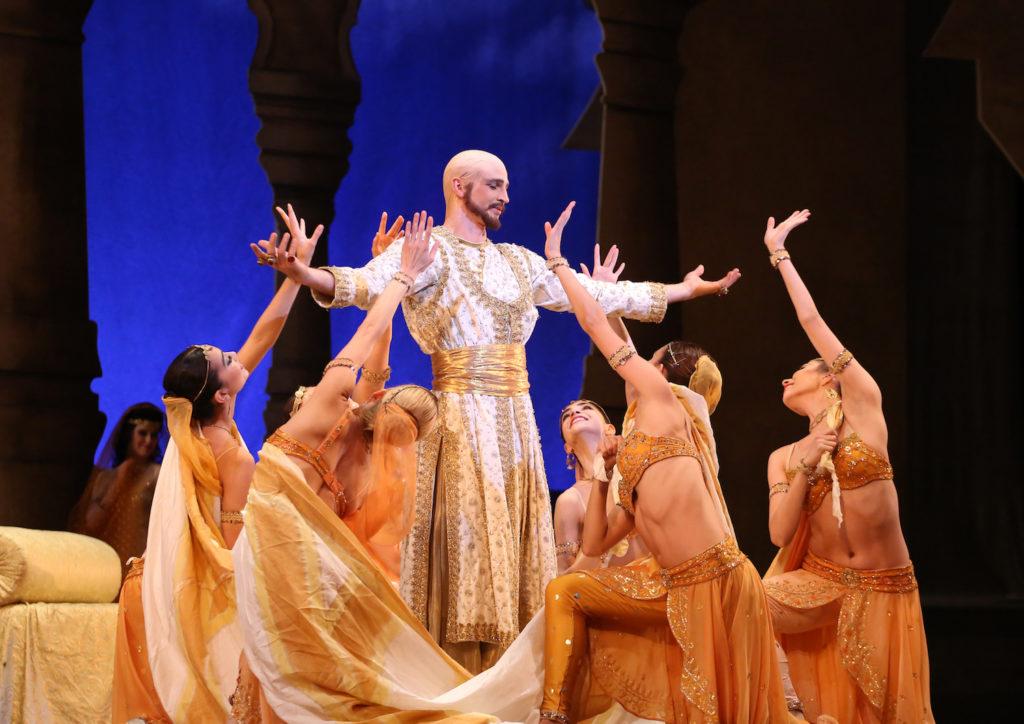By Shaina Richards, deputy news editor
Boston Ballet launched its 53rd season with the North American premiere of “Le Corsaire” at the Boston Opera House on Thursday. “Le Corsaire,” French for “The Pirate,” is a visually captivating show filled with swashbuckling action, romantic duets and comic relief.
In 2007, choreographer Ivan Liška took up the challenge of adapting Marius Pepita’s classic 19th-century version for the Bavarian State Ballet, creating a show for a modern audience. The score in this production, a compilation from five composers selected by Liška, is performed by the Boston Ballet Orchestra.
The story follows the conflict that arises when the wealthy, powerful pasha desires to add a beautiful maiden, Medora, to his harem, and a daring pirate named Conrad becomes fiercely determined to rescue her.
“Le Corsaire is not performed in the United States very often, so we had to learn the entire thing from scratch,” said Patrick Yocum, who joined Boston Ballet Company in 2011 and was promoted to the rank of soloist in 2015. “Ivan’s production is quite complicated – there’s a lot of big groups, village teams and some chaotic sword fighting. One of the biggest challenges was getting the story accurate as it is very complicated.”
Yocum had his premiere on Friday night as the dashing hero of the story, Conrad, and will be performing in two more performances. There are 11 performances in total, but since the company has four casts of principal dancers, they each get several turns to perform.
The beginning of the first act grabbed the attention of the audience as a backdrop of a stormy sky appeared, violins began to play an anxiety-inducing melody and a ship slowly began to emerge in the background.
In each of the various settings and backdrops, vivid colors and details resulted in an incredibly realistic stage. These sets included a marketplace, a pirate island, the pasha’s palace and a garden – the last of which was distinct in being brought to life by students from the Boston Ballet School, who carried flowers as they performed. The scene was particularly well-received, provoking loud applause from the audience.
“It was quite beautiful when they brought out all the floral arrangements and the younger ballet school kids,” said Craig MacLean, a season ticket holder who attended the opening night.
Dancers moved across the stage in sparkling tutus and villager and pirate costumes in breathtaking solo performances, romantic duets and flawlessly choreographed dances – some of which involved 30 performers on stage at once.
“[The show] exceeded what I thought it would be,” said Gabrielle Silberman, a freshman at Boston College.
The dancers began rehearsals on Aug. 15 while also preparing other ballets for the spring season, Yocum said.
“As Conrad, I have very intricate relationships with the other people on stage,” he said. “Some of them are your coworkers, some are your mortal enemies, some are passing acquaintances and one of them is your true love. When all of these people are on stage at the same time, you have to be very obvious about how you interact with each of them.”
The ballet is loosely based on Lord Byron’s verse tale, “The Corsair,” which was published in 1814 and inspired numerous stage adaptations, including many ballets.
“Everybody sort of knew the story back then, but now we’re trying to introduce it to an audience in 2016. A lot of people don’t come into the theatre knowing what they’re about to see,” Yocum said. “We, as dancers and actors, need to make sure that what we portray is very accurate to the story.”
Liška reconstructed “Le Corsaire” out of old notations he found at the Bolshoi Theatre in Moscow and in Harvard University Library’s theatre collection.
“First of all, [Liška] needed to go back into the old notation that is very rarely read any more, so he needed to find someone who could translate this for him,” Yocum said. “Then, he went into the music of the show, which at one time had as many as 26 composers.”
As the ballet has been repeatedly revised for more than about 160 years, every new production would feature new music based on popular composers of the time, he said.
Liška chose music for his reconstructed version by Adolphe Adam, Léo Delibes, Cesare Pugni, Riccardo Drigo and Prinz von Oldenburg out of the original composers.
“What Ivan did was take this jumble of music, tear it apart and reconstruct it,” Yocum said. “He needed to really build it from the ground up and somehow made a feasible ballet with beautiful sets and costumes – and told a good story. I’m in awe of him.”
“Le Corsaire” will be in performance at the Boston Opera House through Nov. 6.
Photo by Dylan Shen










